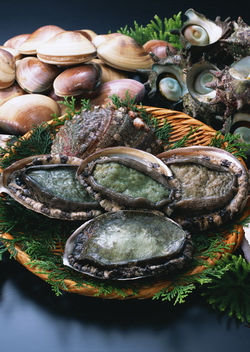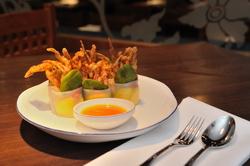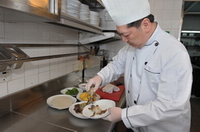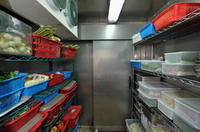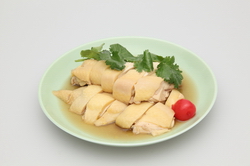
2010 4th Issue
Feature Article (Careful Choice of Hotpot Ingredients for Customers' Safe Consumption)
Christmas and New Year are the busiest times for the food industry. At this time when hotpot restaurants are packed with customers, food businesses should pay attention to the following points in light of the characteristics of hotpot cuisine.
Characteristics of Hotpot Cuisine:
Hotpot restaurants provide raw ingredients for customers to cook by dip boiling on their own. As hotpot is often served in a pot shared by a group of customers, people tend to put in a combination of different food items into the pot before the soup is brought to a boil. However, as different types of food require different cooking times, customers would have to count on their experience to judge if the food is done. In fact, food businesses could start with the handling of ingredients to ensure food safety and hygiene.
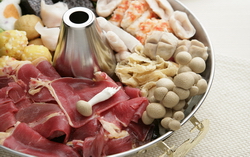
Common ingredients provided by hotpot restaurants are:
Shellfish such as oysters and scallops – scrub and wash the shells. Have them disemboweled, wrapped in cling film and stored in the refrigerator at a temperature between 0 oC and 4 oC. Take out only when they are to be served.
Fish, meat and meat balls – cut the fish and meat into thin slices. Cut meat balls to the centre to allow faster cooking. Frozen food should first be thawed in the refrigerator at a temperature between 0 oC and 4 oC or by microwave oven. Take out only when they are to be served.
Vegetables – should be rinsed under running water for several times and then soaked in clean water for about an hour . Rinse again before storing in the refrigerator at a temperature between 0 oC and 4 oC. Take out only when they are to be served.
Advise customers, either by notices or staff's verbal reminder, to cook food (especially pig livers) thoroughly before consumption and not to dip cooked food in a sauce mixed with raw eggs to prevent Salmonella food poisoning .
Some more points to note:
-
Buy food materials, especially raw oysters and shellfish, from reliable suppliers, and make sure that the food materials are accompanied by health certificates. Keep the invoices for at least 60 days so that problematic food can be traced.
-
Make sure that the refrigerators used for food storage function properly. Keep cooked food above the raw ones.
-
To prevent cross-contamination, always keep the utensils clean. Thoroughly clean and sanitise the bowls and dishes that have been used for holding raw food materials before reuse. Provide two separate sets of wares and utensils for staff and customers to handle raw and cooked food separately. Separate raw and cooked food when serving or displaying food to customers.
-
When providing cooked food, make sure that the food is thoroughly cooked. Generally, core temperature of meat should be at 75 oC or above.
-
Food handlers should observe good personal hygiene: wash hands thoroughly with clean water and soap before and after handling food, and after going to the toilet.
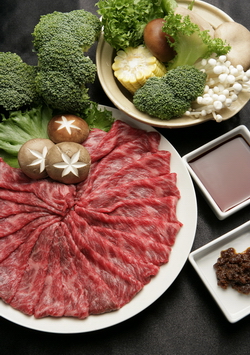
Know More about Common Food Poisoning Bacteria
Vibrio parahaemolyticus
Vibrio parahaemolyticus is a halophilic vibrio often found in the marine environment and seafood. It is highly reproductive. Consumption of seafood (in particular shellfish) that has not been thoroughly cooked may cause bacterial infection. One may develop symptoms including diarrhoea, vomiting, mild fever and abdominal pain, etc. usually within one to two days of being infected. They can recover after replenishing with water and electrolyte together with adequate rest. However, young children, the elderly or persons suffering from gastric diseases will easily get dehydrated upon infection. In this case, antibiotics treatment may be required.
Salmonella spp.
Salmonella species is a group of bacteria that can be found in the intestine of humans as well as wild and domestic animals (including poultry, pigs and pets like dogs, cats and reptiles). A number of Salmonella species can cause food poisoning in humans. The symptoms include nausea, fever, abdominal pain, diarrhoea and sometimes vomiting, which are more severe in infants and the elderly. The incubation period is from 6 to 72 hours, usually about 12 to 36 hours. Food may be contaminated by salmonellae in animal faeces and cross-contamination may occur during further processing and preparation. Salmonellae may survive in the environment and equipment of food-processing facilities. Eating raw or inadequately cooked eggs can easily cause infection.
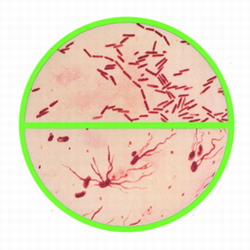
Norovirus
The gastro-intestinal illness caused by noroviruses is usually mild and self-limiting. Symptoms may include nausea, vomiting, diarrhea and abdominal cramps. According to literature, norovirus is a common pathogen of viral gastro-intestinal disease and noroviral gastro-intestinal disease is more common in winter. The only known host for norovirus is infected human. It can be spread by faecal-oral route via contaminated food and water. Other major modes of transmission include person-to-person spread, contact with contaminated object and aerosol spread. As norovirus is commonly found in sewage-contaminated water, the shellfish harvested from polluted water or vegetables irrigated with polluted water are very likely to be contaminated. Ice, salad, raw vegetables and shellfish have been identified as the media of food poisoning outbreaks caused by norovirus. Therefore, consumption of these contaminated foods poses a high risk of norovirus infection. The key to the prevention of norovirus infection is the strict observance of food, personal and environmental hygiene.
Clonorchis sinensis
Clonorchis sinensis is a parasite that can live on or in a host to derive benefit from or at the expense of its host. Infection of Clonorchis sinensis is endemic in Mainland China, Taiwan, Korea and some other countries and areas in Southeast Asia. People are infected by consuming raw or undercooked freshwater fish containing the encysted form of the parasite (metacercariae). Therefore, freshwater fish must be thoroughly cooked before consumption.
Light infections by the fluke cause mild or no symptoms, while large numbers can cause intense infection for long duration and result in loss of appetite, diarrhoea, and fever. The fluke can also cause obstruction of the bile duct and liver cirrhosis. In severe cases, the infection can result in chronic jaundice and eventually the higher occurrence of cholangiocarcinoma (cancer arising from bile duct cells).
For more information, please visit the following website:
http://www.cfs.gov.hk/english/multimedia/multimedia_pub/multimedia_pub_fsf_52_01.html
Food News
(I) Turn and Look for Healthier Food Choices
Nutrition Labelling Series – Nutrient Content Claims

Nutrient content claims, such as "low fat", "high fibre", are the most common nutrition claims found in prepackaged foods nowadays. Nutrient content claims must meet the statutory requirement on nutrient content and 100 g is usually adopted as a benchmark for most foods. When adopting a "low" or "high" claim, the amount of the nutrient concerned must not be over or below the stipulated level. For example, for a "low fat" claim, total fat should not be more than 3 g per 100 g of solid food; for a "high fibre" claim, the dietary fibre should not be less than 6 g per 100 g of solid food.

A "free" or "no" nutrition claim, such as "no sugars", "sodium free" (i.e. "salt free"), is also considered as a type of "nutrient content claim". The use of such claim does not imply that the prepackaged food is free of a particular nutrient. It only means that the food contains an insignificant amount of a nutrient, nearly 0 g per 100 g of food. Take a "no sugars" claim as an example. The food should not contain more than 0.5 g of sugars per 100 g of food.

Despite the use of the same "nutrient content claim" in different prepackaged foods, it does not mean the levels of the nutrient concerned are the same. For example, the level of total fat of two prepackaged foods carrying the same "low fat" claim may differ because the law stipulates that a "low fat" claim can be used if total fat is not more than 3 g per 100 g of solid food. In addition, some prepackaged foods which satisfy the statutory conditions may not be labelled as "low fat". Hence, the nutrition claim can only serve as a quick reference and consumers should read carefully the information on nutrition labels in making a healthy food choice.
Please visit www.nutritionlabel.gov.hk or refer to the leaflet (http://www.cfs.gov.hk/english/programme/programme_nifl/files/UNDERSTAND_E.pdf) to learn more about nutrition claims.
(II) Food Safety Bill

To strengthen control on food safety and safeguard public health, the Food Safety Bill was introduced to the Legislative Council on 2 June 2010. The Bill provides for food safety regulatory measures including, among others, a food traceability mechanism to ensure that the Government can, in case of food incidents, trace the source of problem food more effectively and act promptly. The food traceability mechanism is composed of two elements:
- a registration scheme for food importers and food distributors; and
- a requirement for food traders to maintain proper transaction records to enhance food traceability.
For more information on the Food Safety Bill, please visit the website of the Centre for Food Safety: http://www.cfs.gov.hk/english/food_leg/food_leg.html.
News on New Dishes
Safety Tips on Production of "Soft Shell Crab Fresh Mango Rice Paper Rolls"
The Express has interviewed "Simply Thai", a Signatory of the Food Safety Charter. "Simply Thai" is a widely popular Thai restaurant which provides customers with a comfortable and hygienic environment so that they can feast on the delicious new-style Thai food meticulously prepared by the chefs. "Soft Shell Crab Fresh Mango Rice Paper Rolls" is one of the dishes at "Simply Thai" that are well received by diners. So, what are the secrets of cooking this highly praised dish?
Chef Sunny Suen, the Assistant Executive Chef of "Simply Thai", stated that the secrets of producing Soft Shell Crab Fresh Mango Rice Paper Rolls, which is a dish freshly prepared and cooked to order, include the following:
| How to Prepare | Secrets | |
|---|---|---|
Receiving: 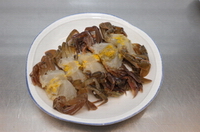 |
First of all, buy good quality soft shell crabs and then wash them thoroughly. | Inspection is a very important step. Food products should be inspected as they are received. Practise the first-in-first-out principle for storage to ensure good food quality. |
Deep-frying :  |
Dry soft shell crabs with paper towels, then coat with the batter evenly and slip into hot oil. Fry to golden brown and remove to drain off excess oil. | When frying the crabs in hot oil, the chef can determine if the crabs are done based on the colour and frying time. This will ensure the food is fully cooked.
|
Soaking: 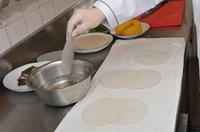 |
Soak Vietnamese rice paper in water until it becomes soft and wipe off excess water. | Wet the rice paper for a few seconds only. Do not soak it in water for too long. |
Rolling: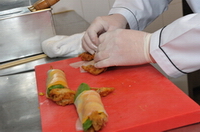 |
Lay out a piece of rice paper and put tender spinach leaves, young ginger slices and mango pieces in the centre. Put the fried soft shell crabs on the other side of the rice paper and roll. | Roll quickly but carefully so as not to break the rice paper. |
Cutting : 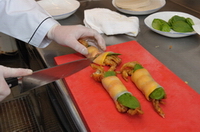 |
Use a knife to cut the roll in half and put the two halves on a plate to serve with dipping sauce. | Use separate utensils for raw food and cooked food to avoid cross contamination. |
Tips from Chef Suen:
-
Undoubtedly we all agree that it requires great skills to make an aromatic and crispy deep-fried batter. According to Chef Suen, the secret of making a very crispy batter is to add an appropriate amount of beer in the batter so that it will give soft shell crabs a crispy texture and the crispiness can last longer.
-
It is vital to use quality ingredients. Chef Suen indicated that their Group will adopt a central procurement strategy when sourcing food ingredients from reliable and reputable suppliers all over the world. In doing so, the ingredients' places of origin can be traced and staff can be assigned to conduct inspections regularly. Moreover, suppliers can be required to provide certification to ensure food hygiene standards are fully met.
-
Kitchen staff are required to have good hygiene practices at work. The "Hygiene Treasure Box" on t he intranet of the Group as well as at its branches provides relevant information and the latest hygiene knowledge to enable the staff to refresh their skills and food hygiene knowledge. All new recruits have to attend a hygiene training course organised by the company.
-
Branch managers will provide sufficient cleaning items (such as antiseptic liquid soap, paper towels, etc.) for the staff. Kitchen staff will clean the kitchen thoroughly and empty refuse bins each night. Arrangements will be made for the cleaning company to carry out monthly disinfection and cleansing thoroughly to maintain hygiene standards.
-
Mangoes and vegetables should be stored at 4 °C in a refrigerator whereas soft shell crabs should be stored at -18°C in a freezer. The temperature inside the refrigerator and freezer will be checked each day to ensure that they are functioning properly.
Lastly, Chef Suen remarked that as a member of the catering trade in Hong Kong , "Simply Thai" has always placed strong emphasis on food quality and the hygiene conditions at its branches so that the customers can consume food with peace of mind. "Simply Thai" has become a Signatory of the Food Safety Charter developed by the Centre for Food Safety since 2008 to join hands with the Government to promote food safety.
What is the Food Safety Charter?
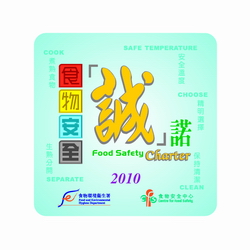
The Food Safety Charter is an endeavour jointly promoted by the Centre for Food Safety (CFS) and the food trade. Since its launching, the Food Safety Charter has been providing facilitation for the food trade to incorporate appropriate food safety measures into their day-to-day operations in providing innovative and client-oriented quality services to Hong Kong citizens and tourists from all over the world. By supporting the Food Safety Charter, food establishments take the lead to promote safe eating, thereby building a good reputation and a healthy image, which is a meaningful way for them to contribute to Hong Kong's catering business. For information on the activities of the Food Safety Charter, please visit the following website of the CFS:
http://www.cfs.gov.hk/english/whatsnew/whatsnew_fstr/whatsnew_fstr_food_safety_charter.htmlCorner of Food Safety Plan
Critical Control Point for Preparing Wine Chicken
During festivals, customers usually get together to enjoy various delicacies. Chicken is one of the indispensable food items. Wine chicken, quite a popular Chinese cold dish, is a mouth-watering delicacy as its meat is fresh and tender with a light taste of liquor. Being a cold dish, it will, however, be contaminated by bacteria (e.g. Salmonella Spp. and Staphylococcus aureus) if not thoroughly cooked or properly stored after cooking. The following guidelines on preparing wine chicken are provided for trade to ensure food safety so the customers can enjoy the food safely.
Cold Knowledge of Cooking Wines
Rice wine, Shaoxing wine and Chinese Rose wine are often used in cooking Chinese dishes. Rice wine, a white wine mainly made from rice, can remove the fishy smell of food and is often used in cooking seafood. Shaoxing wine, a yellow wine mainly made from sticky rice, is often used in cooking wine chicken. Shaoxing wine is also called Huadiao (meaning embossed patterns). In ancient times, Shaoxing wine was given as a gift to families with new born babies in a jar that was normally embossed with colourful patterns. Chinese Rose wine, a Sorghum-based white spirit made from sorghum and roses, is suitable for preparing preserved meat.
Ingredients
Chilled chicken whole
| Seasoning | |
| Ginger | 3 slices |
| Spring onion | 2 stalks (in sections) |
| Salt | 1 teaspoon |
| Shaoxing wine | 250 ml |
Steps:
-
Rinse the chicken.
-
Put the ginger, spring onion, salt and chicken into boiling water. When water reboils, switch the heat to low fire and stew for about 20 minutes.
-
Cool and chop the cooked chicken. Add Shaoxing wine. Cover the chicken properly and put it in the fridge for 4 hours.
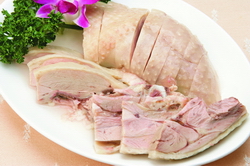


Readers' Corner
Nanotechnology and Food Safety

The Centre for Food Safety (CFS) released in September 2010 a risk assessment study report on nanotechnology and food safety in which was examined the basic principles, applications and the potential health implications associated with the use of nanotechnology in the food sector. In addition, a summary on the current risk assessment approaches adopted by some major countries towards nanotechnology was also provided. For details of the report, please visit the following website:
http://www.cfs.gov.hk/english/programme/programme_rafs/programme_rafs_ft_01_04_Nanotechnology.html
Safety of Nanofood and Food Contact Materials Derived From Nanotechnology
The results of the literature review show that at present, there is no tenable evidence that food or food contact materials derived from nanotechnology is any safer or more dangerous than their conventional counterparts. Since the c haracteristics of nanomaterials vary greatly,no general conclusion can be made on the safety of nanofood. However, so far no evidence has shown that consumption of nanofood will affect human health.
Advice to Trade:
- Traders should ensure the products on sale are safe for human consumption.
- Do not sell nanomaterials that have not undergone safety assessment.
Briefing of Activities

Trade Consultation Forum
The Centre for Food Safety (CFS) believes that tripartite collaboration among the Government, the food trade and consumers is essential in ensuring foods sold in Hong Kong are wholesome and safe for human consumption. To enhance communication with the trade, the CFS has regularly conducted meetings of the Trade Consultation Forum since July 2006. Representatives from various food trade associations, food processors, food importers and wholesalers have been invited to attend the meetings and exchange views on different food safety matters with the CFS.
The twenty-fifth meeting of the Trade Consultation Forum was held on 10 September 2010 . Issues that were of most concern to the trade like nutrition labelling and the Small Volume Exemption Scheme were discussed at the meeting. Officials from the CFS introduced the Draft Code of Practice on Record Keeping Relating to Food to the trade, which aims to assist them in complying with the record keeping requirement under the Food Safety Bill. The trade was also briefed on topics including food colour and hypersensitivity in children and nanotechnology and food safety.
The twenty-sixth meeting of the Trade Consultation Forum was held on 10 November 2010 . Updates on the application for Small Volume Exemption were given and the trade was briefed on the Draft Trade Guidelines on Reducing Acrylamide in Food and the Study on Safety of Melamine-ware Available for Use on Local Food Premises at the meeting. Representatives of the trade actively expressed their views on various issues at the above meetings, which enable the CFS to better understand the demand of the trade.
The twenty-seventh meeting of the Trade Consultation Forum was held on 17 December 2010 . Progress of the Working Group on Nutrition Labelling and Small Volume Exemption application was reported and claims on sports drinks were elaborated at the meeting. The meeting was briefed on the guidelines on providing nutrition information in respect of servings contained in pre-packaged food, the Study on Acrylamide in Some Popular Foods, the Guidelines on Reducing Acrylamide in Food, and A Guide for Food Service and Retail Outlets – Practise Food Hygiene to Prevent Hepatitis A and Hepatitis E. The CFS also took the opportunity to explain issues on Clonorchis and food safety and about the ban in Europe on baby bottles containing bisphenol A to the trade at the meeting.
Food Safety Q&A
Question: Are steviol glycosides permitted sweeteners in Hong Kong ?
Answer: The Amendment Regulation that adds two types of sweeteners (including steviol glycosides) to the Schedule to the Sweeteners in Food Regulations (Cap 132U) took effect on 1 August 2010 . After the Amendment Regulation took effect, steviol glycosides are permitted to be used in food as sweeteners and should be used in accordance with Good Manufacturing Practice (GMP), ie. the quantity added to food should be limited to the lowest possible level necessary to accomplish the desired effect. Steviol glycosides have been evaluated and determined to be safe by the Joint Food and Agricultural Organisation/World Health Organisation Expert Committee on Food Additives (JECFA) and are permitted for use in Mainland China , Japan , Korea , Australia , New Zealand and the U.S. The Codex Committee on Food Additives is taking steps for the inclusion of the uses of steviol glycosides in the General Standard on Food Additives (GSFA).
Facts and Myths
Myths: Storing food in the refrigerator can kill the germs in food.
Facts: Freezing is only a way to slow down the growth of germs using low temperature in order to extend the shelf-life of food products. Under low temperature environment, some germs may be killed but some can still survive. However, most of the germs cannot grow at such low temperature. Many frozen food items have to be defrosted before cooking or eating. Defrosting is a way to soften frozen food and resume its original form. Frozen food should be defrosted properly. Otherwise, the germs in food may grow rapidly. Three defrosting methods are recommended, including: (i) defrosting by putting the food in the lower compartment of the refrigerator; (ii) defrosting under running water; and (iii) defrosting by microwave oven.
Brain Gym
Please link the germ which commonly causes food poisoning to the most relevant food-borne medium.

Answers:

